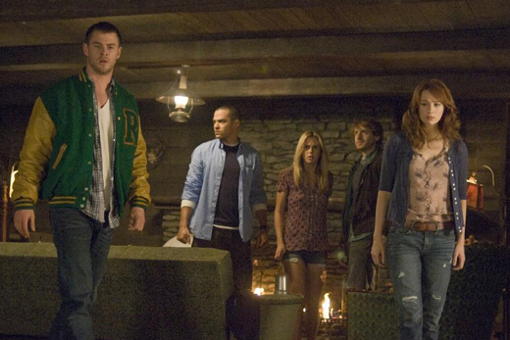By Jim Rohner · April 16, 2012

During a break from classes, five college friends decide to take a trip up to a remote cabin in the woods for a weekend of good-natured debauchery. The standard horror film crew are all assembled for the trip: the goofy stoner friend, Marty (Fran Kranz), who constantly spouts conspiratorial theories about covert puppet masters; the scholarly Holden (Jesse Williams), who was invited to distract the virginal Dana (Kristen Connolly) from her recent heartbreak; and the slutty blonde Jules (Anna Hutchinson) and her jock boyfriend Curt (Chris Hemsworth), who claims that the cabin comes courtesy of a recent purchase by a cousin. Traveling off the map, the youths stop at a gas station that time has seemingly forgot to refuel and ask directions of a tobacco-chewing attendant. They buy enough gas to get them there, but “getting’ back, that’s your concern,” he says. How ominous.
The cabin, sufficiently decrepit, sparsely furnished and in close proximity to a lake, is the quintessential locale for any mischievous teenagers who don’t realize they’ve stepped irrevocably into a horror movie. They carry on drinking, swimming, and partaking in general activities of the intimate variety, though when they stumble upon eery and ominous relics in the cabin’s cellar – a conch, a strange puzzle sphere, a ballerina’s music box, dusty, black & white photos, a century-old diary detailing violent and sexual religious customs – it’s only Marty who seems to logically suggest that “none of this is awesome.” Overall, it’s the kind of formula we’ve seen dozens of horror films for the last 30 years.
But is it?
If this is all par for the course, then what’s the purpose of the two, white collar office workers, Sitterson (Richard Jenkins) and Hadley (Bradley Whitford), that the film keeps cutting back to? What’s the purpose of the high tech, war room-esque control room that they occupy and how are they able to monitor every move the teens make? What’s all this talk about “rigging the game” and how is it that they treat the arrival of the paranormal as business as usual? Why does it seem like they’re engineering the unfolding events and for what higher purpose?
Held up initially due to an abandoned 3D post-conversion and then again due to MGM’s financial woes, The Cabin in the Woods was finally released this past weekend riding a wave of hype and excitement generated from playing on the festival circuit for the last few years. The fact that it hasn’t seen and most likely won’t see big box office numbers is by no means an indication of the film’s quality or the futility of the blogosphere as much as it speaks to the intelligence that co-writers Joss Whedon (Firefly, Buffy the Vampier Slayer) and Drew Goddard (Lost, Cloverfield) display in making a groundbreaking horror film. I’m not saying the American moviegoing public is stupid (I’ll let Adam Sandler’s continued box office speak to that), but they don’t ask for much from their scary movies. As long as there are boobs and gore, the masses are placated. The Cabin in the Woods certainly features those, but it dwells less on them because the filmmakers are not concerned by the “how much” of those elements as much as they’re concerned with the “how and why” of those elements.
It’s difficult to describe or praise The Cabin in the Woods without spoiling anything, but suffice it to say that it’s the kind of horror film that comes around once every few decades that breathes life into the genre by simultaneously poking fun at and having fun with the archetypes that it’s come to be known for. Whedon and Goddard show remarkable intelligence in deconstructing a lot of the familiars that many moviegoers gloss over without much consideration, but also take every opportunity to show that they themselves are horror fans with the countless references and winks to films and filmmakers that have come before them.
On a superficial level, most may be satisfied with the jump scares, the flesh and Marty’s oafish nature, but the ones who’ll really flock to this film, the ones who’ll spread the word and watch it over and over again on DVD, are the horror fanatics, the ones who know the formulas and can appreciate deviation or deconstruction of them. In the 80s, these folks saw through the seemingly climactically challenged April Fool’s Day; they’re the kind who have followed the Scream franchise since its inception in 1996; they made Behind the Mask: The Rise of Leslie Vernon, a cult hit in 2006. The Cabin in the Woods is a spectacular entry into the canon of films that rejuvenate a genre by proving it’s capable of evaluating itself while still having fun within its own parameters and showing that there can be a brain above all those boobs and gushing blood.